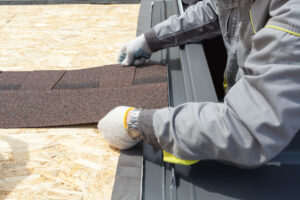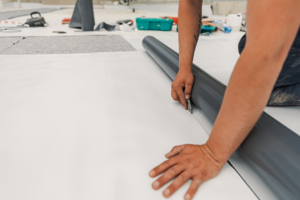When you’re ready to replace the roof on your home, it’s a big undertaking that requires a lot of careful planning and researching. Because the roof plays such an essential role in your home’s structure and safety, it’s important to choose the best type to ensure long-term results.
At Adept Construction, we specialize on four types of roofing: shingle roofing, composite roofing, flat roofing, cedar shake roofing, and flat roofing services. Learn more about each today to narrow down your decision.
Shingle Roofing
Perhaps the most immediately recognizable of the types of roofing, shingles are a roof covering consisting of overlapping flat pieces of material, or shingles. The slats can be made of things like wood, slate, flagstone, fiber cement, metal, plastic, or composite material (more on that later). Roof shingles are very commonly used for residential roofing jobs, and the material used often depends on things like the roof pitch and the construction method.
Flat Roofing
Flat roofs are almost level in contrast to shingle roofs. Where shingle roofs come to a point/angle at the peak, flat roofs are almost totally flat, with a pitch of only about 10 degrees. Flat roofs are used mostly in dry climates where rain and moisture aren’t much of a concern, as well as on buildings where the roof space can be used as additional living space (such as a rooftop deck or rooftop garden). The most common types of flat roofing materials are built-up roof, rubber membrane, and modified bitumen flat roof.
Cedar Shake Roofing
As you may have guessed, cedar shake roofing is roofing constructed with cedar shakes, or, in essence, a wooden roof. Cedar shakes are a bit different from shingles—shingles are sawn from a block, while cedar shakes are split off, creating a more irregular or rustic look. These shakes today are very rarely hand-split, but they still maintain the dimensional rules of cedar shakes of old times. These shakes are thicker than shingles, and don’t tend to lay as flat, which requires a layer of felt paper to be installed along with the shakes to prevent damage from wind-blown precipitation.
Composite Roofing
Finally, composite roofing—these are shingles made out of a blend of materials and fibers. These shingles offer great levels of durability and are fire rated, and are fade-resistant and lightweight. They are also usually cheaper to buy and less costly to install than other roofing options, making them a popular choice.
Get Started On A Roofing Project At Adept Today
For more information about any of these, or to get started on your own roofing project, contact Adept Construction today.
What Are the Basics of a Roofing System?
Roofing systems will include more than a multitude of shingles. Generally, there are five main components that you’ll need to keep in mind when installing a new roof or replacing an older, damaged one. It’s important to understand the fundamentals of what will go into roof construction and ensure that you don’t spend too much on a roofing system if you can avoid it, while also getting the best materials to minimize repairs and replacements.
Roofing Structure
The structure of the roofing includes each rafter along with the overall structure they construct, also referred to as trusses. These structures are specially designed and triangle-shaped, typically customized to meet the specific needs of each building. While they can’t be altered or cut, they effectively transfer the roof’s load to the building’s exterior walls.
Sheaths
Normally, large sheets of plywood or oriented strand board (OSB)—known as sheathing or the deck of the roof—are placed over the roof structure and attached to it.
Flashing
With sheathing installed, flashing comes next. This is typically sheet metal that’s placed around the roof’s joints to prevent leaks. Chimneys, dormers, and air vents that stick out beyond the deck require flashing.
Roof Coverings
Roof coverings are the shingles that most people will see, with asphalt shingles as the most popular option for homes and many businesses. They’re also the cheapest, and may require more frequent replacements than other types of roof coverings.
Cedar shingles and shakes are also available and last longer than asphalt shingles. Flat and slate or tile roofing are other popular options, but costs can vary greatly depending on the materials and the extent of the roofing project.
Drain Systems
In addition to waterproof flashing, homes and businesses should also have an effective drainage system installed, which could include downspouts and eaves troughs that carry water down away from the home, further preventing water buildup and leaks.
Roofing experts can help determine how each of these elements will factor into the home’s roof construction.
What Are the Best Materials for a Roofing System?
When selecting the materials for your roofing, it can be difficult to determine what’s worth getting for a combined long lifespan and reasonable price. Here are some of the best materials to choose from, depending on the type of roof you have.
Asphalt Shingles
Asphalt shingles are a popular choice that’s great for many types of sloped roofs, which come in many different styles and colors. They’re also easily maintained and replaced. Architectural shingles are also ideal for homes that have specific architectural designs that require more than traditional asphalt shingle roofing.
Cedar Shake and Shingle Roofing
Cedar shakes and shingles are also used for the roofing of many homes in lieu of asphalt shingles. They are available in several different grades depending on the roof’s requirements, and they are also commonly used as sidewall in addition to roofing. They are also more capable of meeting the architectural needs of certain home designs.
Composite Roofing
Composite roofing uses shingles made of several different materials including asphalt, fiber cement, recycled plastic, waste paper, or tar paper. First created as a safer alternative to asbestos roofing products that have long been banned, composite roofing offers the same look as a traditional roof, but with added durability and strength. These roofs are capable of withstanding many harsh weather conditions and require less frequent maintenance, while making sure the home remains visually appealing.
Flat Membrane Roofing
Buildings with flat roofs have specific requirements and are more limited in their designs. Flat membrane roofing is a great option, with three different options available depending on the type of roof, including built-up roofs (BUR), modified bitumen, and rubber membrane. However, more mainstream options include asphalt, EPDM, PVC membranes, and TPO, among many others.
Depending on the type of roofing you have, roofing professionals can also help you decide which material is best based on your price range and the building’s architectural specifications. With the help of experts, you can find the perfect roofing system to install for your home or business.










